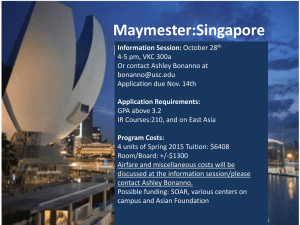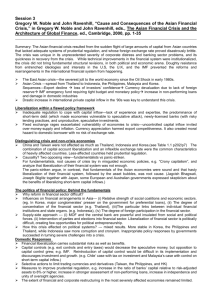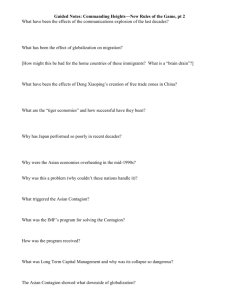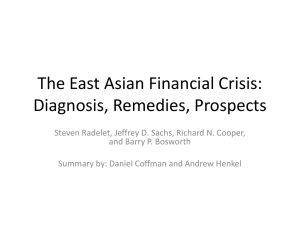Asian financial crisis
advertisement
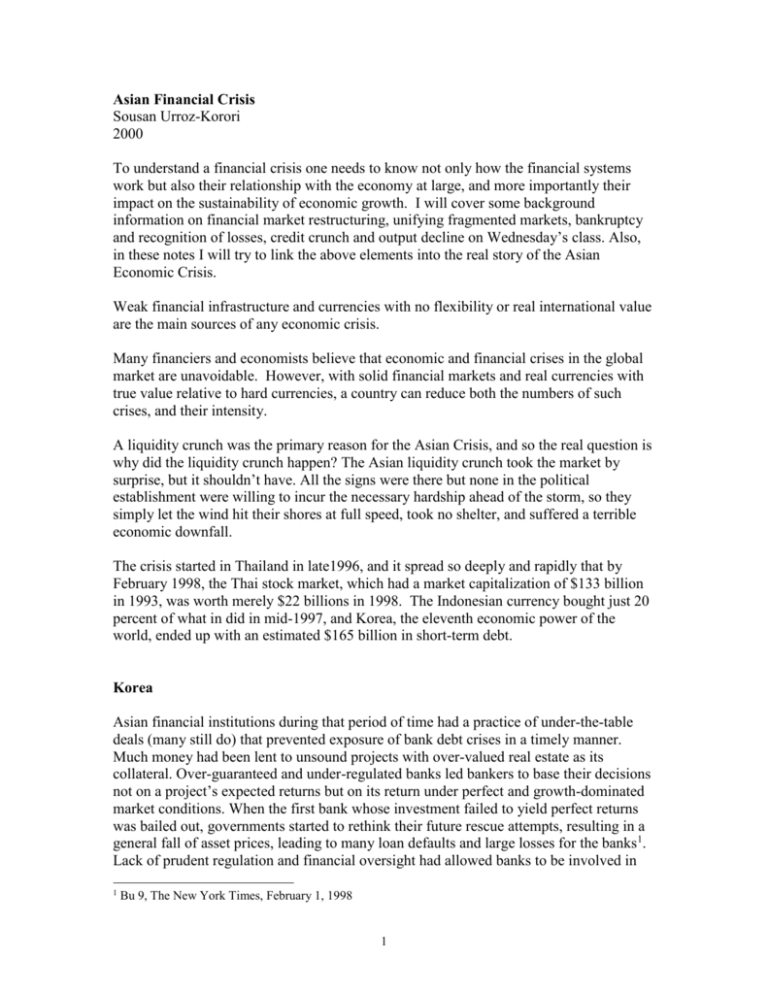
Asian Financial Crisis Sousan Urroz-Korori 2000 To understand a financial crisis one needs to know not only how the financial systems work but also their relationship with the economy at large, and more importantly their impact on the sustainability of economic growth. I will cover some background information on financial market restructuring, unifying fragmented markets, bankruptcy and recognition of losses, credit crunch and output decline on Wednesday’s class. Also, in these notes I will try to link the above elements into the real story of the Asian Economic Crisis. Weak financial infrastructure and currencies with no flexibility or real international value are the main sources of any economic crisis. Many financiers and economists believe that economic and financial crises in the global market are unavoidable. However, with solid financial markets and real currencies with true value relative to hard currencies, a country can reduce both the numbers of such crises, and their intensity. A liquidity crunch was the primary reason for the Asian Crisis, and so the real question is why did the liquidity crunch happen? The Asian liquidity crunch took the market by surprise, but it shouldn’t have. All the signs were there but none in the political establishment were willing to incur the necessary hardship ahead of the storm, so they simply let the wind hit their shores at full speed, took no shelter, and suffered a terrible economic downfall. The crisis started in Thailand in late1996, and it spread so deeply and rapidly that by February 1998, the Thai stock market, which had a market capitalization of $133 billion in 1993, was worth merely $22 billions in 1998. The Indonesian currency bought just 20 percent of what in did in mid-1997, and Korea, the eleventh economic power of the world, ended up with an estimated $165 billion in short-term debt. Korea Asian financial institutions during that period of time had a practice of under-the-table deals (many still do) that prevented exposure of bank debt crises in a timely manner. Much money had been lent to unsound projects with over-valued real estate as its collateral. Over-guaranteed and under-regulated banks led bankers to base their decisions not on a project’s expected returns but on its return under perfect and growth-dominated market conditions. When the first bank whose investment failed to yield perfect returns was bailed out, governments started to rethink their future rescue attempts, resulting in a general fall of asset prices, leading to many loan defaults and large losses for the banks1. Lack of prudent regulation and financial oversight had allowed banks to be involved in 1 Bu 9, The New York Times, February 1, 1998 1 less than sound lending practices and the general population ended up paying the ultimate price. On December 13, 1997, the Economist Journal argued that in order to prevent future crises in Korea “…drastic reforms are required. Directed by successive governments Korean banks have for years thrown free money at the Chaebol conglomerates with political concentration. Such lax credit has allowed the Chaebol to build recklessly huge factories, and to diversify into businesses in which they have no expertise...big companies are deeply in debt, and the banks are overwhelmed by bad loans.” More interestingly, in May of 2001 during the IMF conference in Korea, “Lessons from Korean Experience,” Mr. Chopra2 considered the weakness in Korea’s banking system as the fundamental reason for the Korean crisis. During the first few weeks after the start of financial crisis in Korea, the country received 1.5 billion SDR (Special Drawing Right), about $2 billion from IMF, $3 billion from the World Bank, $2 billion from Asian Development Bank, and $8 billion from the group of industrialized3 countries of the world, all in support of its stabilization and reform4. Korea, by using these direct loans and other long term guarantees with the help of the Fund, tried to consolidate its enormous short-term debt. By January 1998, the total financial commitment of the world to Korea reached $57 billion, the main contributors being the IMF ($21 billion) and the group of industrialized nations ($22 billion). Despite of this massive intervention, support, reforms and adjustments, the Korean stock market lost 70 percent of its value by January 1998. The operation of 14 out of 30 Korean merchant banks was also suspended. Dr. Fischer5, on January 22, 1998, addressing the Midwinter Conference of the Bankers’ Association for Foreign Trade referred to “the failure to dampen overheating6 pressure that had become evident in Thailand and many other countries in the region and manifested in large external deficits and property and stock market bubbles.” It seems Mr. Fischer was trying to blame an overheated economy as the source of the Asian problem. However if one looks very closely at these economies during that period, one sees a pattern of growth that mainly was concentrated on consumption. I believe these countries could have sustained the same level of growth with no crisis if more off the growth was concentrated on creating the much needed infrastructure (roads, harbors, airports…), and imports of fundamental goods (train, ships...), The resulting equilibrium would have prevented overheating conditions. Also, if the financial infrastructure had built on sound foundations, then the market automatically would slow down the allocation of funds through short-term lending. Ajai Chopra, IMF’s Asian and Pacific Department, IMF Survey, July 16, 2001. Australia, Belgium, Canada, France, Germany, Italy, the Netherlands, New Zealand, Sweden, Switzerland, the UK., and the US. 4 International Monetary Fund News Brief No. 97/32, Washington, D.C. 5 Dr. Stanley Fischer was the first Deputy Managing Director of IMF during Asian Crisis. 6 Average growth rate of 8 percent annually for almost a decade for many of the Asian countries. 2 3 2 (I want to bring out one factor which I think has significant relevancy in our discussion: during this crisis period the share of U.S. exports to these countries increased substantially. The Asian countries imported 19 percent of their goods from the US in 1996, up from 15 percent in 1990. Even though at this point I do not have backing data, I believe that many of the short-term consumption loans must have supported this growth, allowing consumers to go after more expensive American goods.) Thailand There is a common acceptance that the Asian Crisis did start in Thailand in 1996. The growth in consumption in that market had attracted large capital inflows since the early 90s mainly in U.S. dollars7. Thailand had enjoyed many years of low short-term interest rates which not only facilitated the capital inflow, but also had allowed domestic banks to expand their lending capacity, fueled and backed by unreasonably overpriced real estate. Many of the loans, even though short-term, had financed real estate and commercial over-development. The Thai authorities, like other Asian governments, failed either to understand the depth of their problem, or to intervene. Increasing the interest rate gradually and on time could have prevented a full-blown crisis. However, as the pressure in the market became unbearable, in July of 1996 Thailand began to float the Thai bath. Depreciation of the bath was the start of investor nervousness and the beginning of liquidation and expatriation of capital out of Thailand. The crisis broke out in full scale at this time. The government of Thailand once again intervened, but rather than allowing for the closing of sick and inefficient financial units, that through their own greed had created most of the problem, the Bank of Thailand, from July to August of 1996, lent out more than $19 billion (over 10 percent of Thailand’s GDP) to keep 91 finance companies afloat8, most of which were insolvent at the time. Thailand suffered from too much cheap money and a financial system that could not allocate the money efficiently or effectively. Thailand needed help, and of course the international community was ready to bail her out. The total financial commitment was for $17.2 billion, $4 billion from the IMF, $1.5 billion from the World Bank, $1.2 billion from the Asian Development Bank, and $500 million each in guarantees from the neighboring Indonesian and Korean governments. Why and how Indonesia, with its own problems, was persuaded to join this rescue is beyond our discussion but deserves some thought. 7 Thai Bath was pegged in US dollars which allowed just minor fluctuation in exchange rate, ideal position for capital inflow with no fear from devaluation. 8 Thailand Gets the Bill, The Economist Journal, August 9, 1997. 3 Indonesia In Indonesia by the end of 1997, the banks were holding over $65 billion in private sector loans. Within a period less than six months the rupiah, the Indonesian currency, dropped from 2,450 to the dollar in July of 1997, to 17,000 to the dollar by January 1998. People who had lost their trust in the banking system were withdrawing their money from banks in sacks. However, the lack of trust in the banking system was not the end of it; there was no trust in the rupiah either. Both domestic and foreign investors, small and large, were exchanging their rupiah to any hard currency, from dollars to yens. A combination of lack of trust to the government and the economy, had put Indonesia in and economic “ground zero.” On January 27, 1998, the government proposed state guarantees on all bank deposits and loans, including foreign-dominated borrowing, and an independent body to rehabilitate its troubled banks. However, the problems of short-term corporate debt and political uncertainty continued, which combined with the large government deficit, deepened the crisis. In some estimates, at the time the country had $80 billion of short-term foreign debt by its corporate sector, either through direct loans or letter of credits. In most cases the domestic banks were the intermediaries who had facilitated this crisis. Weak banking regulation, lack of supervision, deep-rooted corruption in the banking sector, and by government officials were at the heart of the problem. Indonesia lost its credit rating, which meant bankruptcy for hundreds of companies, and millions lost their jobs, while the cause of the problem – the banks – were being rescued. Since much of the foreign short-term debt belonged to the western banks, the IMF was forced to step in. The International Monetary Fund had its own requests which included restructuring of the banking system, asking the government not to support insolvent institutions, and allowing them to go bankrupt. No special treatment was to be provided for shareholders of institutions that have lost their capital, and support was to be given to financial institutions that were undercapitalized but solvent, but only if the institution was willing to undertake incisive restructuring program as a milestone on the road to full financial health. In Indonesia sixteen insolvent banks were closed, and small depositors were compensated through payments administered by Bank Indonesia. The liquidity support to solvent banks was collateralized. It was also requested the state bank be downsized and gradually privatized. This is a task that the current government of Indonesia is quite behind in, and reluctant to undertake. Indonesia received total assistance of $40 billion for achieving stability, ten coming from the Fund, 4.5 from the World Bank, 3.5 from the Asian Development Bank and 3 from the United States. Other Asian nations and Australia covered the rest. 4 Taiwan During this period of crisis in Asia, Taiwan stood high and alone in the storm. Even though its currency slipped a modest 15 percent its stock exchange gained 17 percent 9, and the GDP grew 6.7% in 1997. The Asian financial crisis was triggered when foreign lenders refused to renew loan to countries with current account deficits and large shortterm foreign debts. None of that applied to Taiwan, which at that time had a current account surplus for seventeen consecutive years and was a large net creditor to the world. The secret of Taiwan was (and is) an efficient capital market which was fairly informal, that moved savings to small entrepreneurs through small, semi-regulated, supervised, private commercial banks, effectively but carefully. Further analysis of Taiwan banking sector and financial market is beyond the scope of this class. Following is a summary of potential topics for class discussion: 1- Creation of an international organization to monitor and report on short-term capital flow both regionally and internationally in order to avoid credit crunch and rapid liquidity swings. This body could be placed under supervision of IMF but should have an independent agenda, and not a political one. 2- All financial firms who hold deposits and act as trustees for the public should be required to use internationally accepted accounting practices and to disclose material financial information. 3- The lack of financial transparency and the practice of under-the table deal making needs to be evaluated and addressed. Often such financial practices are woven into day-to-day business practices. A change would require drastic modification to the business culture. 4- The banks should be required to put their own capital at risk, and the governments should stop the practice of covering bank losses. A mandatory insurance should provide risk protection to all depositors within an acceptable margin. The insurance premium should be paid directly by banks as the cost of doing business. 5- The capital market should be regulated but liberalized. Often these two words have been used as opposites. However, if financial institutions have no barriers and can compete anywhere in the world, the service charges to the consumer drops, resulting in cheaper money being available for business development. The business risk to international banks drop when there is no fear of capital sterilization, and when the market can allocate the funds solely based on creativity and soundness of the projects. Of course such market is going to vulnerable unless trained independent bank examiners closely supervise it. The task should be a function of independent central banks. If such independence does not exist, then an independent body should be created. 9 Forbes, January 12, 1998 5 6- The governments should stay away from trying to operate banks; their tasks should be limited to stabilization of currency and other monetary policies, and assessing the health of banking system through an independent central bank. 7- All attempts should be made to encourage informal rural banking to cover higher risk and diversified consumers. Credit unions and other cooperative financial institutions have grown tremendously in developed countries in recent years, with very positive results. In addition to Credit Unions, there is also a need and a market for microfinance units that not only can mobilize small savings but also can take higherrisk clients and give them financial means to start micro-enterprises. These activities should be undertaken by supporting already existing commercial banks and nongovernmental organizations (NGOs). Unfortunately, in recent years many problems with NGOs have surfaced, including corruption and lack of efficiency. Not every NGO has had problems but a careful assessment is required. In general, financial creativity, transparency, support of privatized smaller banks, support of competition, complemented with simplified regulation and strong banking supervision should guide us through this crises-avoidance task. A country that does not have a solid, creative, open financial system cannot mobilize capital. Intermediaries should be able to allocate capital efficiently and attract long-term returns rather than just short-term rent. International Monetary Fund The International Monetary Fund was created after the Second World War with the mandate of looking after the international monetary system. “Its rules were embodied in the Articles of Agreement and an institution was established to interpret, adjudicate and police them and, by short-term lending, to facilitate adherence to them”10. In order to assure that links among trade, investment, and balance of payments policies were recognized, a country had to be a member of IMF. The elimination of exchange controls was a main objective of the fund. The task was to assure reasonable stability of exchange rate combined with national independence in monetary and fiscal policy. As a condition for membership, each country had to subscribe an individual quota based on its relative size and economic strength, of which 25 percent had to be in gold and the remainder in its national currency. Any member could in effect borrow from these resources up to 25 percent of its quota each year for a period of five years -- based on their gold reserves. These “Drawing Rights” provided accessible credit to supplement members’ international reserve in the form of a “stand by” agreement. A member confronting a “fundamental disequilibrium” in its balance of payments must consult with IMF. 10 pp. 457, Baldwin, Richardson, International Trade and Finance, 1974, Canada, Little Brown & Company Limited. 6 During the financial crisis of Asia, the IMF intervened, on the one hand with carrot and in the other with stick; it approved loans in exchange for structural changes in banking, business, and government functions. Critics in recent years have argued that “the knowledge that IMF financing will be made available with the event of a financial crisis make the crisis more likely to occur”11. These critics may have some basis for their argument, given the fact that since 1995 the IMF has bailed out Mexico, East Asia, Russia, Brazil and Argentina (still having liquidity problems). However Lane’s and Phillips’ findings within the limited scope of work does not support this phenomena; the fact remains that IMF requirements often interfere with internal decision process of independent countries. In general there is no real basis to IMF critics’ argument, since not enough imperical study has been done to support them. The Fund is a political body, since US (17.16% of all votes), Japan (6.16%), Germany (6.02%) have the bulk of the vote. There is no possibility for any agenda to be considered unless one of the above countries has an interest in it. In support of this statement I will share in class some IMF decisions between 1993 and 1997. In addition, even though historically the IMF has talked about and requested transparency from many governments, its own activity is much too secretive. Further discussion in this topic is beyond the scope of this class. However, I believe that a restructured, streamlined, leaner IMF is much needed, given current levels of globalization in finance and trade. The New IMF should aspire to become a preventive institution rather than a rescuing body. It should be an advisory entity rather than enforcing institution. It should create a set of regulations, including international banking supervision, that can audit and assure the health of the world’s financial institution. 11 Lane, Phillips, IMF Financing and Moral Hazard, Washington D.C., Finance and Development Journal, June 2001 7 References: 1- Lane, Phillips, IMF Financing and Moral Hazard, Washington D.C., Finance and Development Journal, June 2001 2- East Asian Economies, Tigers adrift, the Economist Journal, March 7, 1998 3- Forbes, January 12, 1998 4- Thailand Gets the Bill, The Economist Journal, August 19, 1997 5- The New York Times, Bu 9, Sunday, February 1, 1998 6- International Monetary Fund News Brief, No. 97/32, Washington D.C., International Monetary Fund 7- Baldwin, Richardon, International Trade & Finance, 1974, Canada, Little Brown & Company Limited. 8- Indonesia Survey, Suharto’s end-game, the Economist Journal, July 26th, 1997 9- Ellsworth, Leith, The International Economy, 1975, New York, Macmillan Publishing Co. 10- The Nation Indonesia, Now the Hard Part, Asiaweek, January 30, 1998 11- A Banking Meltdown, The Economist Journal, January 23, 1998 12- USIA Report, Financial Instability in Asia: The U.S. Response, December 1997, January 1998, http/ www.usia.gov/regional/ea/asiafin/bailout.htm 13- Asia, South Korea’s meltdown, the Economist Journal, December 13, 1997. 8
